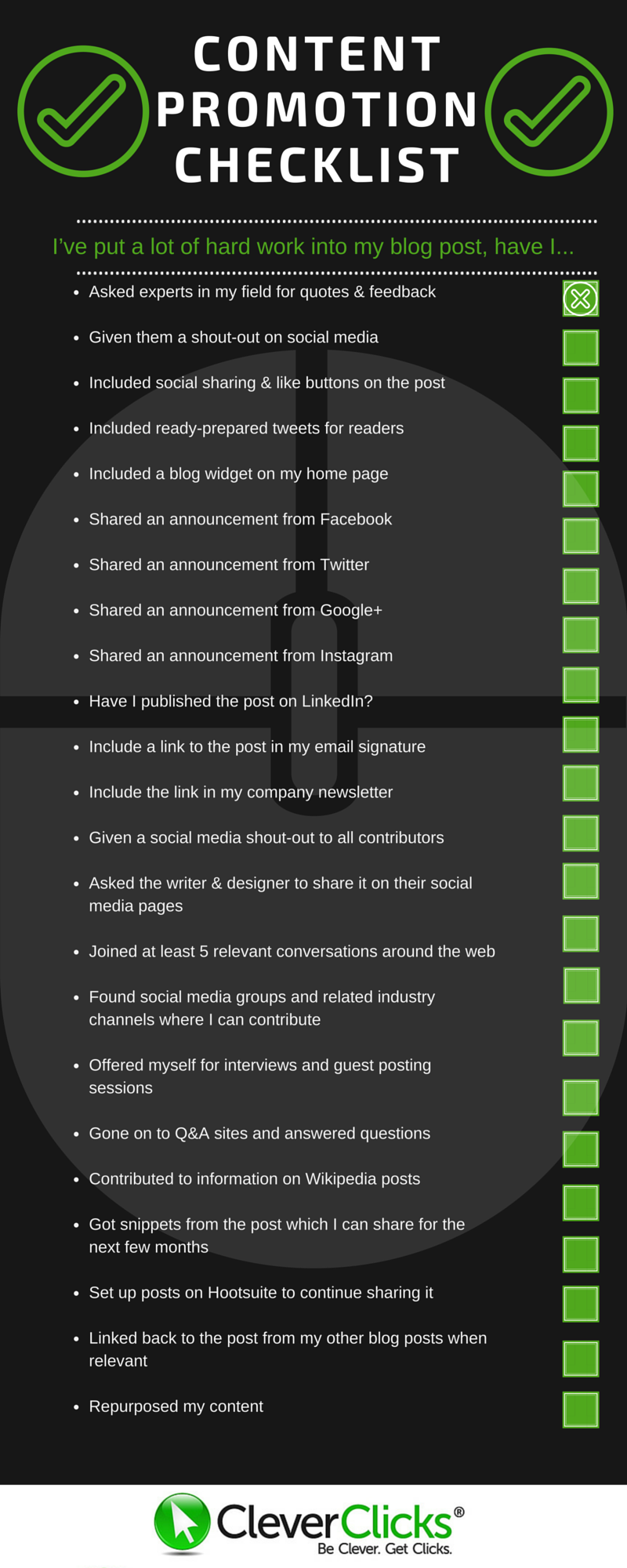If content is king then content promotion is the kingdom, because without the latter the former is pretty much just a guy in a tiara.
Yes, there will always be a market for excellent content, but with a landscape as saturated as digital (we read the equivalent of 174 newspapers of data every day) it’s silly to think that your content will somehow find its own way and float to the top while so many other are fighting ferociously to get there. Content promotion, when done right, gives your content the boost it needs to succeed and is a way of ensuring ROI on your hard work.
If you’re putting hours into creating content it’s madness not to make sure it finishes well; like a runner who completes an entire marathon only to pull out 2 strides before the finish. The bottom line is that unless your domain authority is on par with YouTube, you really aren’t going to get the results you deserve from your posts without a solid content promotion strategy.
With that in mind, we’ve put together a simple checklist which you can run through before and after you create a post. Obviously we haven’t included every promotion strategy possible, but if you’re a new to the game this is a great place to start. The list itself can be found as a printout at the bottom of this post, but the text which follows will offer a bit more context – if you’re interested.
Step 1: Flattery will get you everywhere

Content promotion begins before the post even goes live. While writing the post, reach out to other experts or influencers in the field and ask them for quotes to include in your writing. Most of the time they’re only too willing to oblige as it’s an opportunity for self-promotion and it’s always flattering to be asked to share your opinions.
For you, not only do these ‘expert quotes’ bolster the authority of your piece, they also act as ego bait* and, once the post is published you’ve guaranteed yourself a couple of extra views (from the influencer or their company), and almost certainly a tweet or retweet when you mention them on social media.
* Ego bait is an attempt to bait an influencer into sharing or promoting your content by mentioning them in it.
Another win-win tactic is to reach out to influencers (or people you respect in your industry) and send them a draft of your post before it has been published.
Ask them to critique and give you insights or feedback on your post – and be super appreciative when they do. This not only gives you the opportunity to improve your piece, but it also gives you the chance to build a rapport with them. Once you’ve published it you can give them a shout-out, show them the final product and ask them to write a comment at the bottom to help get a conversation started. They might also be inclined to share or link to it on their site.

Step 2: Sharing is caring
On the post itself you need to make it as easy as possible for people to find and share your content. The easiest ways to do this are as follows:
- Include Social Sharing Buttons
If you’re not sure, these are the buttons at the bottom of most blog pages that allow readers to share the post on social media. Most hosting software makes adding them very easy, all you have to do is select the social media you’d like to include and it’s done for you.
Just a word of caution: make sure the link you’ve included has been shortened (a site like Bitly will let you do this for free) – otherwise your readers will end up with a long, ugly link that they can’t even Tweet.
- Social Like Boxes
Similar to sharing buttons, these allow people to ‘like’ the post on Facebook (or the equivalent on other channels) without having to leave the page to do so.
- Include ready-prepared tweets
If you share interesting data, quotes or sharable information, it’s often a good idea to create a ready-prepared Tweet for readers. That way they can post these quotes/stats straight from your blog page (and you’ll get a chance to include your link and handle in their post).
Step 3: Socialise

So your blog is live and optimised for social sharing. Hurrah. Now tell people about it. You need to make sure that as many people as possible see it, and not just those who may be searching for it. Here are a few of the easiest ways to do that:
- First (and obviously), share an announcement that the post has gone live from every social media channel that you have.
- @Mention any sources you’ve used in the blog on social media as this encourages more views and shares

- Have a widget on your company home page which displays your latest and most popular blog posts.
- Include a link (and thumbnail image) of each new post in your company email signature – this means that every email you or your employees send throughout the day will act as free advertising. Tools like WiseStamp will help you do this without having to update it manually.
- Include an announcement and link about your latest blog posts in your internal and external company newsletters
- Make sure the writer and anyone else involved with the post boats about it on their personal social media pages.
Step 4: Get chatting

Now is the time to get a little more pro-active with your promotion. Using the general chatter around the web you can take advantage of various sources to help promote your post. How? By finding conversations to which you can contribute information, insightful comments and, of course, a link to your blog post, ‘for more information’.
- Set up Google alerts to notify you when any brands mention or talk about your blog’s topic or theme.
This allows you to pick up immediately on any buzz surrounding your content so that you can find and join relevant conversations around the web.
For example, if you wrote a post about copy-checking:
You can use Google Alerts to help you find forums, social media channels, groups, blog comments and other places that your content topic or themes are being mentioned and discussed.
Step 5: Give your 2 cents’ worth

You’ve got all this great information, it’d be selfish not to share it, and lucky for you the internet happens to be the biggest knowledge sharing platform there is. Here are a few key ways to do it strategically:
- Contribute to the information on relevant Wikipedia posts and reference your blog post as an external source. If your knowledge is correct and valuable Wiki will include it on their page (and this is rather fantastic as they happen to be rather popular, in case you didn’t know).
- Similarly, head on to Q and A sites like Quora and Ask.com and search for any questions related to your post’s field. Then answer those questions and include your blog post’s link in your answer. But beware: no one like a selfish sharer, so don’t just give your link and call it a day. Rather, answer their questions as best you can and simply post your link as your resource (see example above).
- Offer yourself for interviews and guest posts. Don’t just wait for it to happen, you can reach out to people and be proactive. Chances are at some stage in the interview or post you’ll find an opportunity to mention ‘that excellent blog post you wrote on the topic a few weeks ago’…
Step 6: Bring it home

This one is simple: keep at it. Don’t stop promoting the last post just because a new one went up. Keep sharing your posts on social media for the rest of the year – at least!
- Set up a Hootsuite account and keep sharing your posts on a rotational basis.
- Pull out quotes, facts and interesting snippets from your posts and share them periodically on social media, linking back to your post each time.
- Keep your Google Alerts set up and an eye on relevant social media conversations and contribute wherever possible.
- Turn your successful posts into infographics, your infographics into videos and your videos into white papers – in other words: repurpose your content and promote it anew. You’ve already done the research so you may as well get a little more bang for your buck.
And there you have it. A few simple yet effective content promotion strategies to send you on your merry way. Below is the checklist. Save it, print it, keep it and refer to it every time you think about hitting publish.

Featured Images Courtesy of Pacific Northwest Agricultural Safety and Health Center on Flickr.com
Images Courtesy of Joseph Francis on Flickr.com
Images Courtesy of mkhmarketing on Flickr.com
Images Courtesy of Dan Thoburn on Flickr.com
Images Courtesy of Blake Patterson on Flickr.com
Images Courtesy of ArtBrom on Flickr.com
Tags: content marketing, content promotion, social media
Stay In The Know
Cut the clutter and stay on top of important news like this. We handpick the single most noteworthy news of the week and send it directly to subscribers. Join the club to stay in the know…



About Steph Von der Heyde
Our resident wordsmith’s love of digital lured her over from advertising to the online space, where she fell in love with content marketing. Since coming to the online world Steph has made her mark on all outgoing CleverClicks copy and is passionate about using words to build brands. Her obsession with the writing is rivaled only by her love of trail running, yoga and green juice. When she’s not submerged in content strategy you’ll find Steph in Downward Dog.